全文HTML
--> --> -->另一方面, 未来信息技术对集成芯片提出了更高的要求, 譬如传输速度更快、信道容量更大以及集成度更高. 通常信息的载体有光子和电子, 电子集成技术近些年来发展迅猛, 而光子作为自然界传播信息最快的载体在芯片集成技术上却相对落后. 基于超构材料对电磁波的高效调控, 光子集成设计方法与超构材料结合可以在一个微小的光学芯片上对光子进行高效的调控, 由此带来很多功能性很强的器件. Rahm等[34]和Roberts等[35]在理论上提出在电磁波导中利用超构材料技术可实现光束各种角度的拐弯、分束、扩束以及聚焦等光学功能器件. 在光子集成技术中, 金属表面等离激元是一种自由电子在电磁波作用下集体振荡产生极化波, 能将电磁波压缩到亚波长的尺寸. 因此金属表面等离激元可以作为未来高度集成光子芯片的信息载体. 2010年, 两个研究组[36,37]利用变换光学原理并结合超构材料技术在芯片上实现了可见光波段的金属表面等离激元传播的调控. 当金属表面等离激元传播遇到障碍物时, 其能量有很强的散射损失, 如果将理论设计的超构材料包裹在障碍物上, 金属表面等离激元可以越过障碍物而没有任何散射, 这种特殊的芯片设计方法极大地提高了光子传输对杂质的免疫能力. 正是基于这种方法, 张翔研究组[38]利用灰度电子束曝光方法制备了光子芯片, 实现了近红外波段金属表面等离激元传输的调控, 如可以将金属表面等离激元进行几乎没有能量损失的聚焦. 这种方法也实现了近红外波段多功能的光子芯片[39], 即一块光子芯片同时具有对金属表面等离激元进行聚焦和扩束的功能.
早期, 人们尝试在凝聚态物质中模拟广义相对论效应. 这种研究方法源于类比思想, 是物理学研究中一个重要的思想方法. 以电动力学早期发展为例, 电磁、磁场及其规律是类比流速场及其规律, 例如涡旋、源、汇等概念的引入. 这对于推动电磁学的发展至关重要. 基于相同的思想, 凝聚态体系也被用来研究一些由于天文观测手段限制而无法观测的广义相对论现象, 其中最突出的例子就是霍金[40]提出黑洞辐射不久, 安鲁[41]在1981年提出了类比引力的声学黑洞模型, 其直观的物理图像是用流体中的声波来类比弯曲时空中的电磁波. 对于以一定速度逆流而上的声波, 当流体的速度超过声速时, 声波被流体拖曳会困在该流体超声的区域. 这个超声区域可以类比视界, 从而可进一步在声学视界上观测声子的霍金辐射. 当声学黑洞模型被提出后, 人们在超导电子线路[42]、简并的Fermi气体[43]、3He超流体[44]、玻色-爱因斯坦凝聚体[45-47]以及离子阱[48]等多个体系中模拟研究了霍金-安鲁效应. Philbin等[49]在光纤体系中利用光纤介质的克尔效应在实验上实现了类比视界, 并观测到视界附近的蓝移现象. 实验上类比视界是利用超快脉冲改变光纤介质的折射率, 随后注入弱的探测光. 由于探测光的速度稍快, 当它靠近脉冲光时, 光纤折射率因克尔效应增大, 从而导致其速度减小, 直至相对脉冲光静止. 最近, 同样在光纤体系中, 人们成功观测到类霍金的受激自发辐射[50]. Berliorno等[51]在熔融的二氧化硅玻璃中注入激光脉冲也在实验上实现了类霍金的自发辐射. Yu和Hu[52]在综述文章中对不同的物理体系模拟霍金-安鲁效应进行了较为系统的总结. 除了霍金辐射之外, Bekenstein等[53]利用非线性晶体的热效应研究了引力场的非线性动力学效应, 并观测到由于电磁波包与引力场相互作用而产生的引力红移和蓝移. Roger等[54]同样利用非线性晶体的热效应模拟了玻色子恒星的演化. 正是基于类比思想, 很多被广义相对论所预言但是很难被观察到的现象可以在实验室环境下被重复细致地研究.
最近十多年来, 超构材料作为一种人工可调控的微结构材料, 也被拓展到类比引力的研究中. Smolyaninov等[55,56]提出利用双曲超构材料可以模拟时空结构的改变. 双曲超构材料是电磁超构材料的一个重要分支, 其有着特殊的色散关系:















本文介绍了不同类型的超构材料光子芯片的特点和利用其特点开展的类比引力的研究. 这种类比研究的基本思路是从超构材料中的电磁波方程出发, 根据材料的电磁参数与时空度规的等价性, 利用超构材料控制电磁参数在空间的分布来模拟弯曲时空. 最后对在超构材料芯片上类比引力研究进行了相应的总结与展望.
 图 1 (a) 绝热变化的波导实现的隐身斗篷; (b) 绝热变化的透镜实现打破衍射极限的远场成像; (c) 金属微球夹在金属/介质/金属的三明治结构之间实现黑洞的模拟; (d) 具有奇异点的金属结构对表面等离激元的纳米聚焦; (e) 具有一些奇异点表面等离激元结构模拟紧致空间
图 1 (a) 绝热变化的波导实现的隐身斗篷; (b) 绝热变化的透镜实现打破衍射极限的远场成像; (c) 金属微球夹在金属/介质/金属的三明治结构之间实现黑洞的模拟; (d) 具有奇异点的金属结构对表面等离激元的纳米聚焦; (e) 具有一些奇异点表面等离激元结构模拟紧致空间Figure1. (a) Tapered waveguide acting as an optical cloak; (b) far-field imaging with breaking diffraction limitation using plasmonic lens with adiabatic change structure; nanofocusing using tapered plasmonic waveguides; (c) the emulation of black hole using a silver microsphere sandwiched by a metal-insulator-metal structure; (d) nanofocusing using metallic nanoparticle with structure singularity; (e) a transformation compacts three dimensions into two dimensions.




渐变光学波导除了可实现纳米聚焦和超高分辨率成像以外, 还可以展开类比引力现象的研究. Sheng等[79]在理论上提出, 将金属微球嵌在金属/介质/金属波导的结构中 (图1(c))可以实现可见光波段各向同性黑洞的模拟, 这里是利用金属球与底层金属板之间的间隙实现了黑洞的势场. 在理论数值计算中, 观测到当金属表面等离激元的入射半径小于黑洞光子球尺寸时, 金属表面等离激元会被黑洞捕获并聚焦. 由于金属表面等离激元在传播过程中有着很强的欧姆损耗, 在实验上观测到这种金属表面等离激元的黑洞存在挑战. 为了克服金属表面等离激元的损耗, 渐变聚合物介质波导被用来模拟可见光波段的人工黑洞. 首先从均匀的平板波导出发, 在二氧化硅基底上镀上一层金属银膜, 再旋涂上一层聚合物介质(polymethyl methacrylate, PMMA). 从计算的平板波导的色散关系可以看出, 对于任一激发的波长, 这种平板波导的等效折射率跟介质层的厚度有关. 在一定的厚度范围内, 随着介质层厚度的增加, 等效折射率从空气的折射率绝热增加介质本身的折射率, 因此实验上可以连续改变介质层的厚度来调控等效折射率的分布, 从而实现模拟广义相对论的弯曲时空. 在Sheng等[80]的工作中, 在实验上使用旋涂加热工艺制备了渐变的介质波导芯片, 利用聚合物与微球之间的表面张力效应(图2(b))构造出介质层的厚度按照中心对称形式非均匀变化的波导, 实现了类似黑洞引力场的等效势场. 这种类比黑洞势场的微腔可以很好地模拟光子在黑洞引力场中传播时由于引力而产生的弯曲(图2(c)). 与此同时, 这种人工黑洞的光学微腔与普通的共振光学微腔相比具有宽波段捕获光子的能力, 在宽波段的激光光源、光电探测以及光伏器件等领域有着潜在的应用价值.
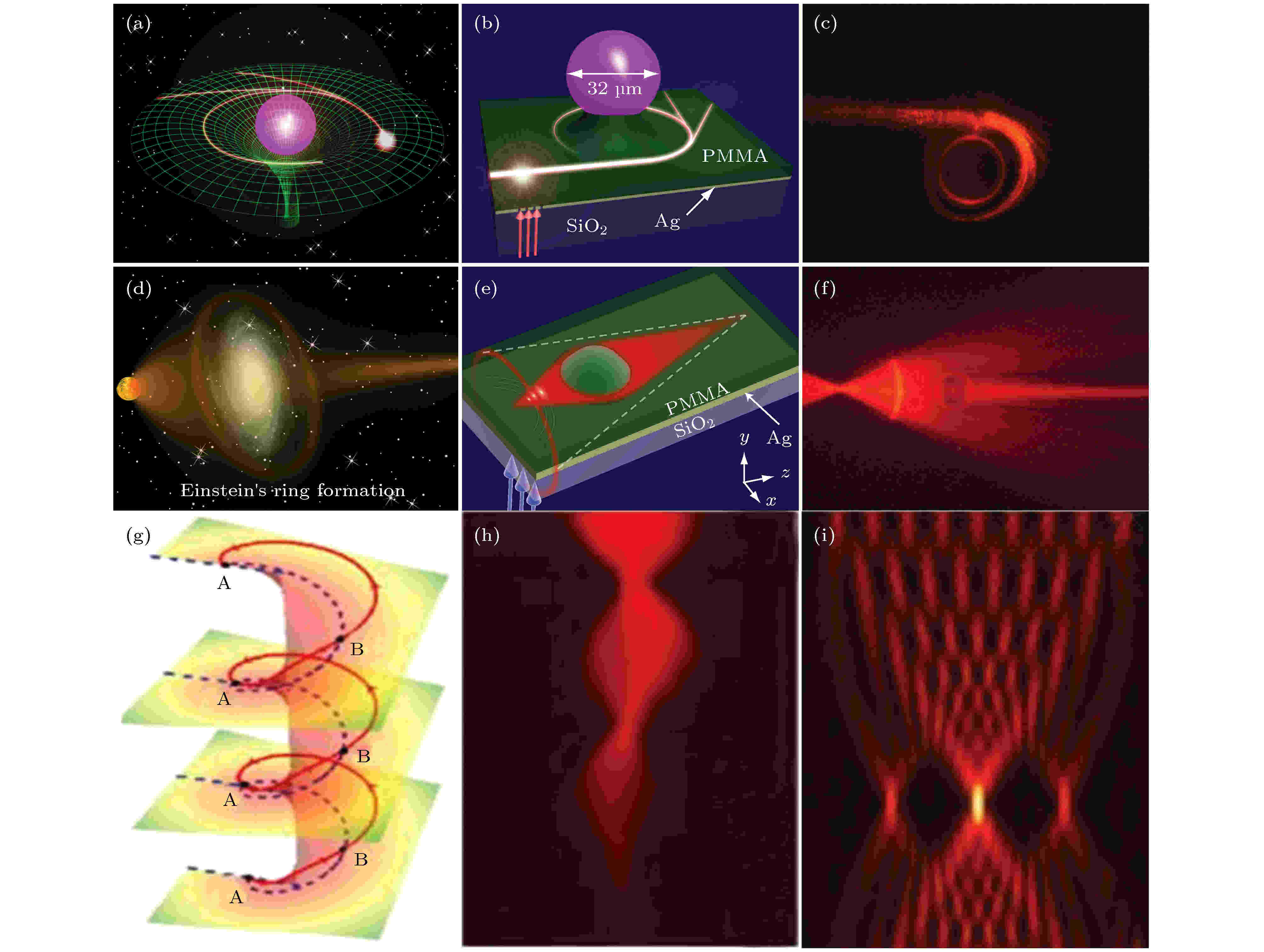 图 2 (a) 引力透镜的效应的示意图; (b) 在渐变的介质波导芯片中模拟黑洞的引力透镜效应的示意图; (c) 人工黑洞对光子的捕获; (d) 爱因斯坦环的示意图; (e) 渐变的介质波导芯片中模拟爱因斯坦环的示意图; (f) 模拟爱因斯坦环的实验结果图; (g) 在黎曼曲面上光线的传播; (h)共形Talbot效应的实验结果; (i)利用共形Talbot效应演示的数字编码的传输
图 2 (a) 引力透镜的效应的示意图; (b) 在渐变的介质波导芯片中模拟黑洞的引力透镜效应的示意图; (c) 人工黑洞对光子的捕获; (d) 爱因斯坦环的示意图; (e) 渐变的介质波导芯片中模拟爱因斯坦环的示意图; (f) 模拟爱因斯坦环的实验结果图; (g) 在黎曼曲面上光线的传播; (h)共形Talbot效应的实验结果; (i)利用共形Talbot效应演示的数字编码的传输Figure2. (a) The schematic of gravitational lensing effect; (b) the emulation of the gravitational lensing of the black hole using adiabatic change dielectric waveguides on a photonic chip; (c) the light trapping of an artificial black hole; (d) the schematic of Einstein ring; (e) the emulation of Einstein ring using adiabatic change dielectric waveguides on a photonic chip; (f) the experiment result of the emulation of Einstein ring; (g) the light propagation on Riemann’s space; (h) the experimental result of conformal Talbot effect; (i) digital coding using the conformal Talbot effect.
渐变介质波导光子芯片除了可以模拟黑洞对光子的捕获, 还可以模拟一些广义相对论预测的罕见天文现象, 譬如爱因斯坦环. 它的形成原因同样来源于大质量天体的引力透镜效应. 当遥远天体发出的光经过大质量天体附近时会由于引力透镜效应产生汇聚, 观测者能在大质量天体附近观测到遥远天体的一系列环状成像(图1(d)). Sheng等[81]通过液滴的表面张力效应, 制备出了一种模拟天体中心引力场的聚合物波导(图2(e)). 实验中激发弧形光栅模拟遥远天体所需要的球面波的波前, 当发散的光经过“天体”时会由于引力透镜效应而重新聚焦. 进一步在实验中采用可见光波段的量子点荧光成像技术直接观测到爱因斯坦环的形成过程, 测量了重新聚焦的光束宽度与传播距离的关系如图2(f)所示, 同时比较实验所得的结果与爱因斯坦所预测环的角尺寸大小, 二者符合得很好. 这种渐变的介质波导芯片除了模拟弯曲时空中广义相对论的现象, 还可以对电磁波的波前进行调控, 譬如在线性重力场中实现高斯波包与非衍射的艾里波包的相互转换[82]. Wang等[83]利用共形变换光学理论, 将麦克斯韦鱼眼透镜通过指数共形变换映射到物理空间, 并结合黎曼页支割线分析(图2(g)), 得到了Mikaelian透镜. 借助于聚合物溶液表面张力自组织过程, 利用这种渐变光学波导制备出了Mikaelian透镜, 并且演示了几何光学条件下的自聚焦特性和类正弦曲线. 同时在芯片上实现了非衍射的Talbot效应, 如图2(h)所示, 可以将图像无损耗地传递到远方. 通过进一步研究, 该器件可以将数据编码无衍射地长距离传输, 因此在信息编码传递方面有着潜在的应用价值. 除了透镜功能之外, 这种渐变的光学波导芯片被实验证明可以实现大角度的光束拐弯[84].
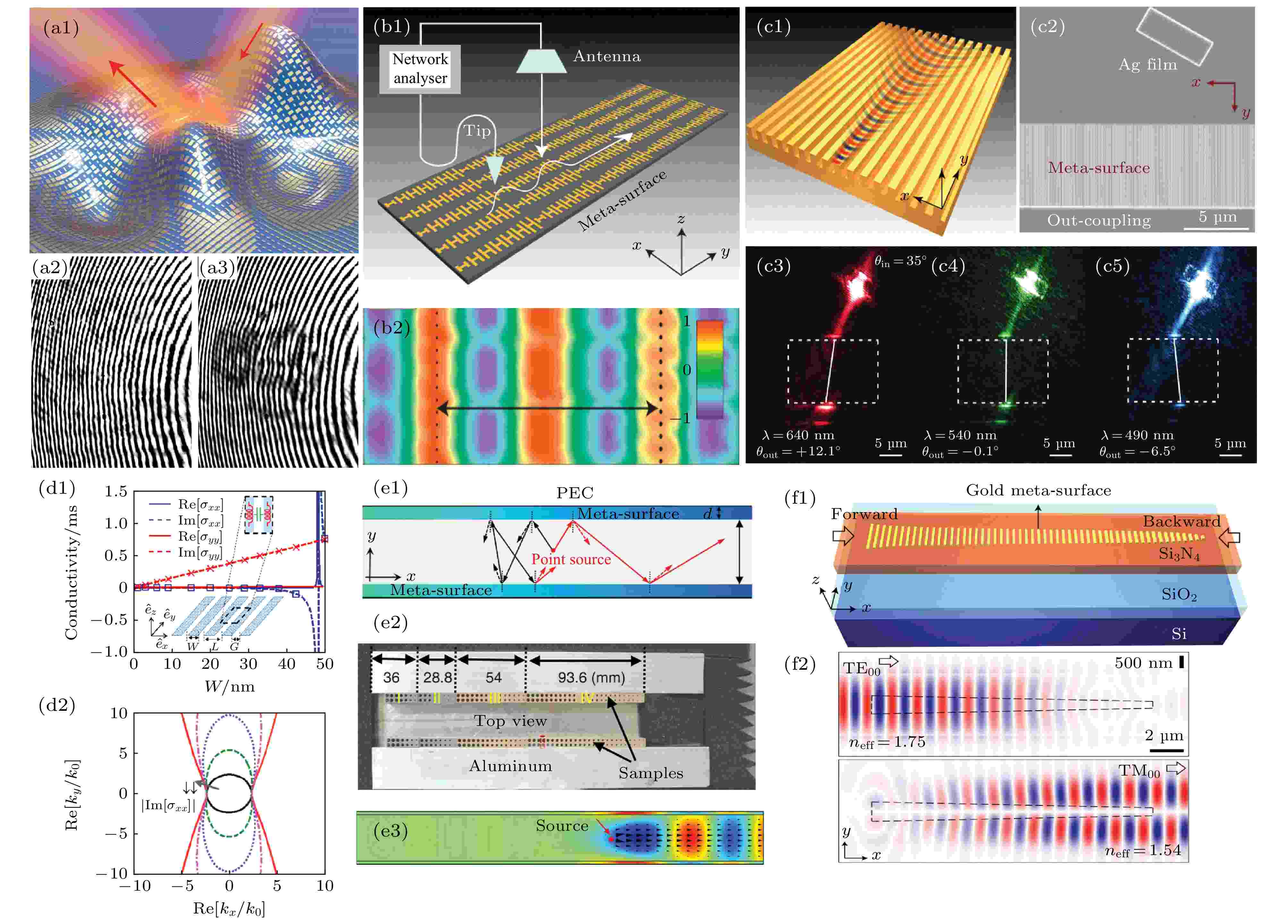 图 3 (a1)?(a3) 皮肤隐身衣, 其中(a1) 利用超表面实现皮肤隐身衣的示意图, (a2)有隐身衣时的效果, (a3) 没有隐身衣时的效果; (b1), (b2) 渐变超表面实现电磁波从远场到近场的高效转换, 其中(b1) 渐变超表面波导的示意图; (b2) 近场扫描的实验结果; (c1)?(c5) 超表面波导对表面等离激元的高效调控, 其中(c1) 超表面的表面等离激元波导的示意图, (c2) 超表面的表面等离激元波导的样品图, (c3)?(c5) 在超表面的表面等离激元波导上实现正折射、零折射、负折射; (d1), (d2) 石墨烯超表面实现表面等离激元色散的拓扑相变, 其中(d1) 石墨烯超表面对电导率的调控, (d2) 石墨烯超表面实现表面等离激元色散; (e1)?(e3)超表面波导实现不对称的电磁传输, 其中(e1)超表面波导的示意图, (e2)实验样品图, (e3)实验结果; (f1), (f2) 超表面波导实现电磁模式的转换, 其中(f1) 渐变超表面波导示意图; (f2)电磁模式转换的实验结果
图 3 (a1)?(a3) 皮肤隐身衣, 其中(a1) 利用超表面实现皮肤隐身衣的示意图, (a2)有隐身衣时的效果, (a3) 没有隐身衣时的效果; (b1), (b2) 渐变超表面实现电磁波从远场到近场的高效转换, 其中(b1) 渐变超表面波导的示意图; (b2) 近场扫描的实验结果; (c1)?(c5) 超表面波导对表面等离激元的高效调控, 其中(c1) 超表面的表面等离激元波导的示意图, (c2) 超表面的表面等离激元波导的样品图, (c3)?(c5) 在超表面的表面等离激元波导上实现正折射、零折射、负折射; (d1), (d2) 石墨烯超表面实现表面等离激元色散的拓扑相变, 其中(d1) 石墨烯超表面对电导率的调控, (d2) 石墨烯超表面实现表面等离激元色散; (e1)?(e3)超表面波导实现不对称的电磁传输, 其中(e1)超表面波导的示意图, (e2)实验样品图, (e3)实验结果; (f1), (f2) 超表面波导实现电磁模式的转换, 其中(f1) 渐变超表面波导示意图; (f2)电磁模式转换的实验结果Figure3. (a1)?(a3) Skin cloaking: (a1) Schematic of skin cloaking using metasurfaces; (a2) the reflection case with skin cloaking; (a3) the reflection case without skin cloaking. (b1), (b2) A gradient-index metasurface used to convert a freely propagating wave to a surface wave: (b1) Schematic picture describing the near-field scanning technique; (b2) the experimental result using near-field scanning. (c1)?(c5) Metasurface waveguide for manipulating surface plasmons: (c1) Schematic illustration of a metasurface made of periodic metallic gratings; (c2) a scanning electron microscope image of a device; (c3)?(c5) images of SPP refraction at metasurface waveguides. (d1), (d2) Topological transitions for surface plasmon propagation using grapheme metasurface: (d1) Effective conductivity tensor of the uniaxial metasurface waveguide; (d2) isofrequency contours of grapheme metasurface waveguides. (e1)?(e3) The asymmetric propagation of electromagnetic waves using metasurface waveguide: (e1) Schematic diagram of a metasurface waveguide; (e2) the fabricated sample; (e3) the experimental result. (f1), (f2) The manipulation of waveguide modes using a metasurface waveguide: (f1) Schematic of a working device; (f2) the experimental result demonstrates mode converts.
基于超表面对表面波的高效调控, 超表面波导光子芯片也可以被用来展开类比引力的研究[99]. 理论学家认为宇宙从大爆炸诞生、演化到现在, 随着温度的降低, 宇宙时空经过了一系列量子相变过程, 这种相变会导致时空真空场的对称性破缺, 而在宇宙中留下各种拓扑缺陷, 例如磁单极子和宇宙弦等. 通过探测这些时空的拓扑缺陷, 人们不但可以追溯早期宇宙的诞生过程, 还能观测量子引力效应, 研究时空的本质. 虽然人们已经开始尝试寻找时空拓扑缺陷, 但由于探测技术的局限, 目前尚未成功. Sheng等[100]制备了一种二维弯曲超材料, 如图4(a)和图4(b)所示, 实现了一种新型的具有轴向旋转对称的超构材料光子芯片, 其旋转对称中心可以模拟一维时空拓扑缺陷—宇宙弦. 虽然宇宙弦不会像其他质量的天体那样在周围时空中直接产生引力场, 但是会造成周围时空拓扑结构的改变, 导致时空角度的缺损或盈余, 光在这种拓扑时空中传播时, 无论光子的入射位置、传播方向、波长以及偏振方向如何, 都会产生一个确定的偏转角






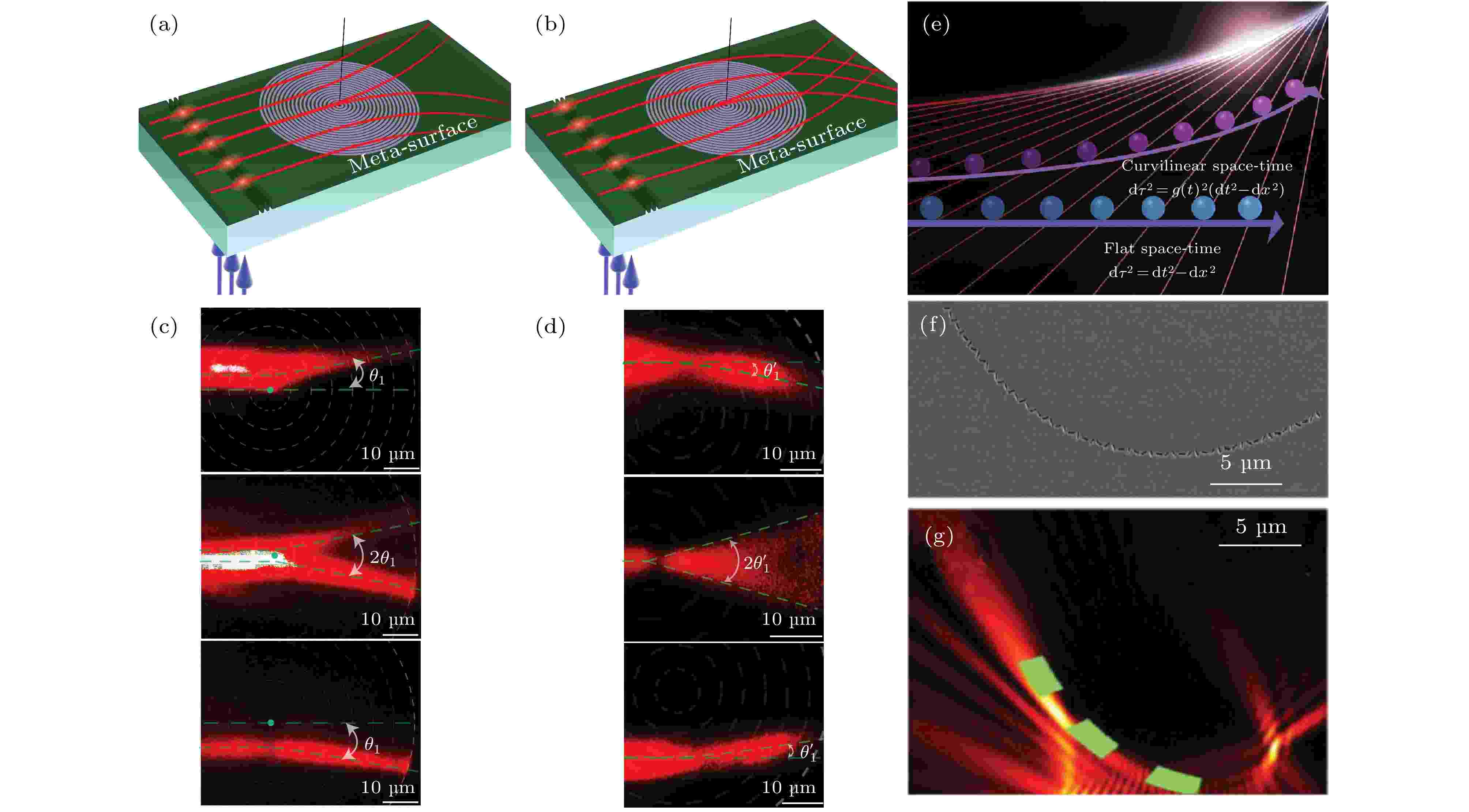 图 4 (a) 由超表面波导构造的负质量密度宇宙弦的示意图; (b) 由超表面波导构造的正质量密度宇宙弦的示意图; (c)负质量密度宇宙弦对电磁波散射的实验结果图; (d)正质量密度宇宙弦对电磁波散射的实验结果图; (e) 由超表面波导模拟加速空间中的粒子运动与轫致辐射的示意图; (f) 实验样品照片; (g) 实验测量的等离激元波束
图 4 (a) 由超表面波导构造的负质量密度宇宙弦的示意图; (b) 由超表面波导构造的正质量密度宇宙弦的示意图; (c)负质量密度宇宙弦对电磁波散射的实验结果图; (d)正质量密度宇宙弦对电磁波散射的实验结果图; (e) 由超表面波导模拟加速空间中的粒子运动与轫致辐射的示意图; (f) 实验样品照片; (g) 实验测量的等离激元波束Figure4. (a) Schematic of cosmic string with negative mass density using metasurace waveguides; (b) the electromagnetic scattering in the spacetime of cosmic string with positive mass density; (c) the experimental results to emulate negative cosmic string; (d) the experimental results to emulate positive cosmic string; (e) the schematic of mimicking Bremsstrahlung radiation of moving particles; (f) the scanning electron microscope image of a sample; (g) the experimental result of surface plasmon rays.
除了模拟时空拓扑缺陷—宇宙弦, 超表面波导光子芯片还可以用来模拟弯曲时空中粒子轫致辐射. 根据量子力学理论, 粒子具有内禀自由度, 并且会与外部空间相互作用从而产生很多丰富可观测的效应, 譬如弯曲空间的自旋霍尔效应. 光子是自旋为1的玻色子. Zhong等[101]将光自旋引入超构材料光学芯片, 通过同时改变超构材料整体的弯曲形状和结构单元局域的旋转角度, 调控时空中自旋光子态的几何相位模拟弯曲时空中粒子的加速运动和轫致辐射(图4(e)). 在实验中采用聚焦离子束技术, 制备了超表面/介质/金属板的光学结构(图4(f)). 超表面由金属纳米孔作为结构单元, 纳米孔与金属板之间的耦合可以产生强的局域磁共振, 以便增强等离激元的激发效率. 实验中在一块具体样品中设计和构造了广义相对论中的伦德勒时空, 模拟了加速坐标系中的轫致辐射, 实现了自由空间的自旋光子到超表面光子芯片上伦德勒等离激元光束的转化. 理论上研究了不同弯曲时空度规之间的的广义协变, 发现了一系列满足广义协变等价的弯曲超构材料, 并在实验上予以证实. 相比较传统变换光学方法通过改变材料的电磁参数的方式, 这种通过调控光自旋子几何位相的方法具有更大的自由度, 而且更容易通过实验实现.
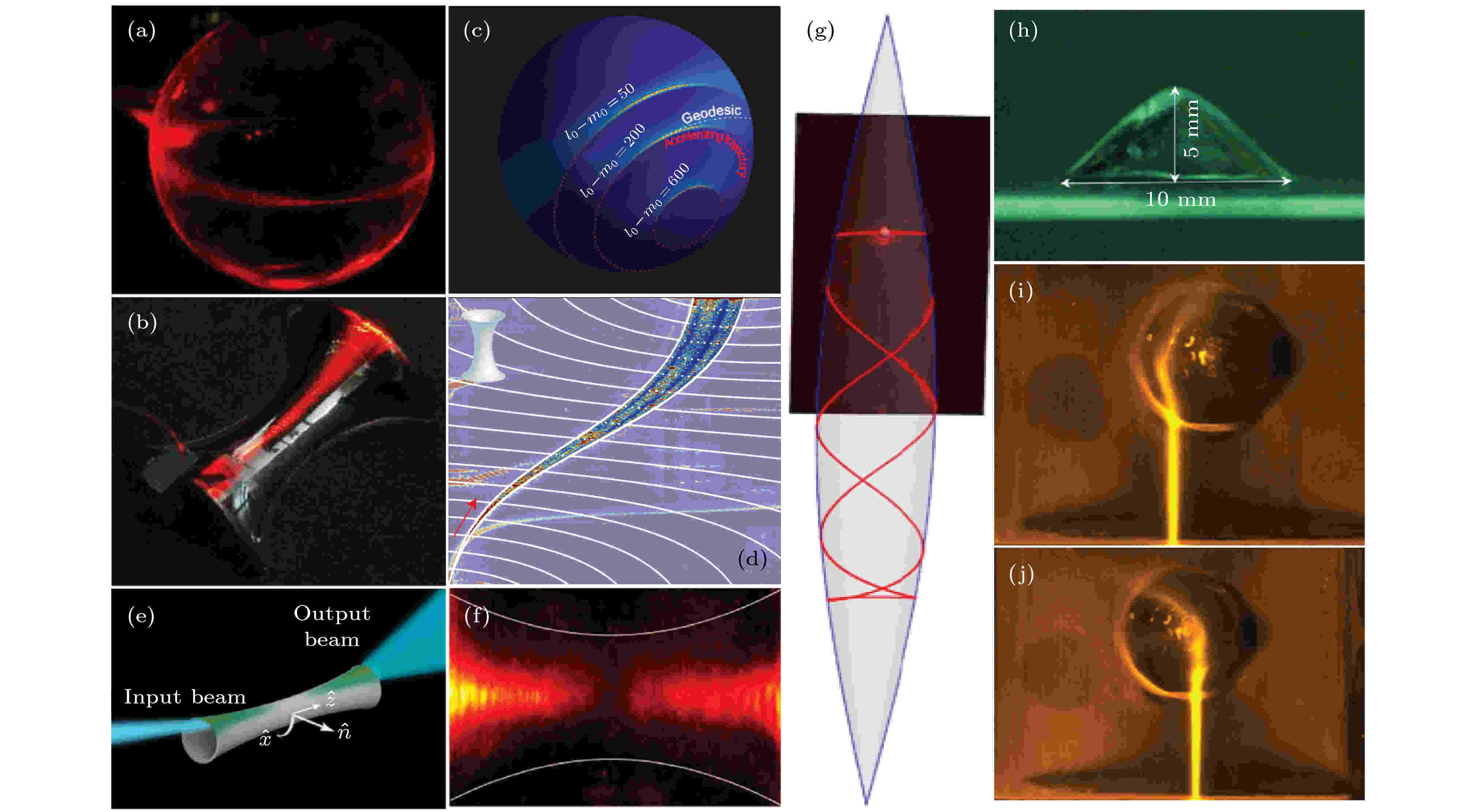 图 5 (a) 在球面上电磁波导的传播; (b) 在马鞍面上电磁波导的传播; (c) 加速波包在球面上远离测地线的传播; (d) 在马鞍面上电磁波导传播的干涉; (e) 电磁波在Flamm形曲面传播的示意图; (f) 空间曲率对弯曲波导衍射的影响; (g) 弯曲曲面上的测地线透镜; (h) 实验制备的旋转锥形结构; (i), (j) 旋转锥形结构对曲面上电磁波的散射
图 5 (a) 在球面上电磁波导的传播; (b) 在马鞍面上电磁波导的传播; (c) 加速波包在球面上远离测地线的传播; (d) 在马鞍面上电磁波导传播的干涉; (e) 电磁波在Flamm形曲面传播的示意图; (f) 空间曲率对弯曲波导衍射的影响; (g) 弯曲曲面上的测地线透镜; (h) 实验制备的旋转锥形结构; (i), (j) 旋转锥形结构对曲面上电磁波的散射Figure5. (a) Propagating electromagnetic waves on a sphere waveguide; (b) the propagating electromagnetic waves on a saddle waveguide; (c) the observation of accelerating wave packets on a sphere waveguide; (d) the interference of electromagnetic waves on a sphere waveguide; (e) schematic of the coupling scheme of the light to the paraboloid waveguide; (f) curvature effects on diffraction; (g) the geodesic lens on a curved space; (h) the side view of experimental cone structure; (i), (j) the experimental results of electromagnetic waves scattered by the cone structure.





在量子力学中描述单电子波函数演化的薛定谔方程是









除此之外, 波导阵列还可以用来研究广义相对论的现象. Szameit研究组[126]利用飞秒激光直写技术制备出了一维双组元的波导阵列, 研究发现, 波导阵列在布里渊区带边处的色散关系与广义相对论下自由粒子的能量-动量关系相同, 同时在布里渊区带边处波导阵列的演化方程与一维狄拉克方程是类似的, 更有意思的是, 在这种波导阵列中观察到了狄拉克粒子正负能量对相互干涉而产生的Zitterbewegung效应(图6(a)). 进一步, 该研究组[127]利用弯曲的波导模拟交变电场, 从而在这种弯曲的一维双组元波导阵列中模拟量子电动力学真空中正负能量粒子对的产生 (图6(b)). 除此之外, 这种弯曲的波导阵列还可以模拟零质量狄拉克粒子波函数的特殊演化[128]. 同时该研究组[129]还利用飞秒直写的波导阵列模拟了天使粒子—Majorana费米子 (图6(c)). Marini等[130]利用上下两层垂直放置的双组元的波导阵列, 通过调控波导阵列的等效折射率实现了不同质量狄拉克费米子演化方程的耦合, 从而模拟了中微子的振荡 (图6(d)). 以上这些波导阵列的工作都是模拟了平直时空的量子场论的效应. Koke等[131]利用波导阵列模拟量子场论的现象, 研究从平直时空拓展到弯曲时空, 通过将弯曲时空的狄拉克方程与耦合波导阵列建立联系, 研究弯曲时空中正负粒子对的产生以及相对论的Zitterbewegung效应.
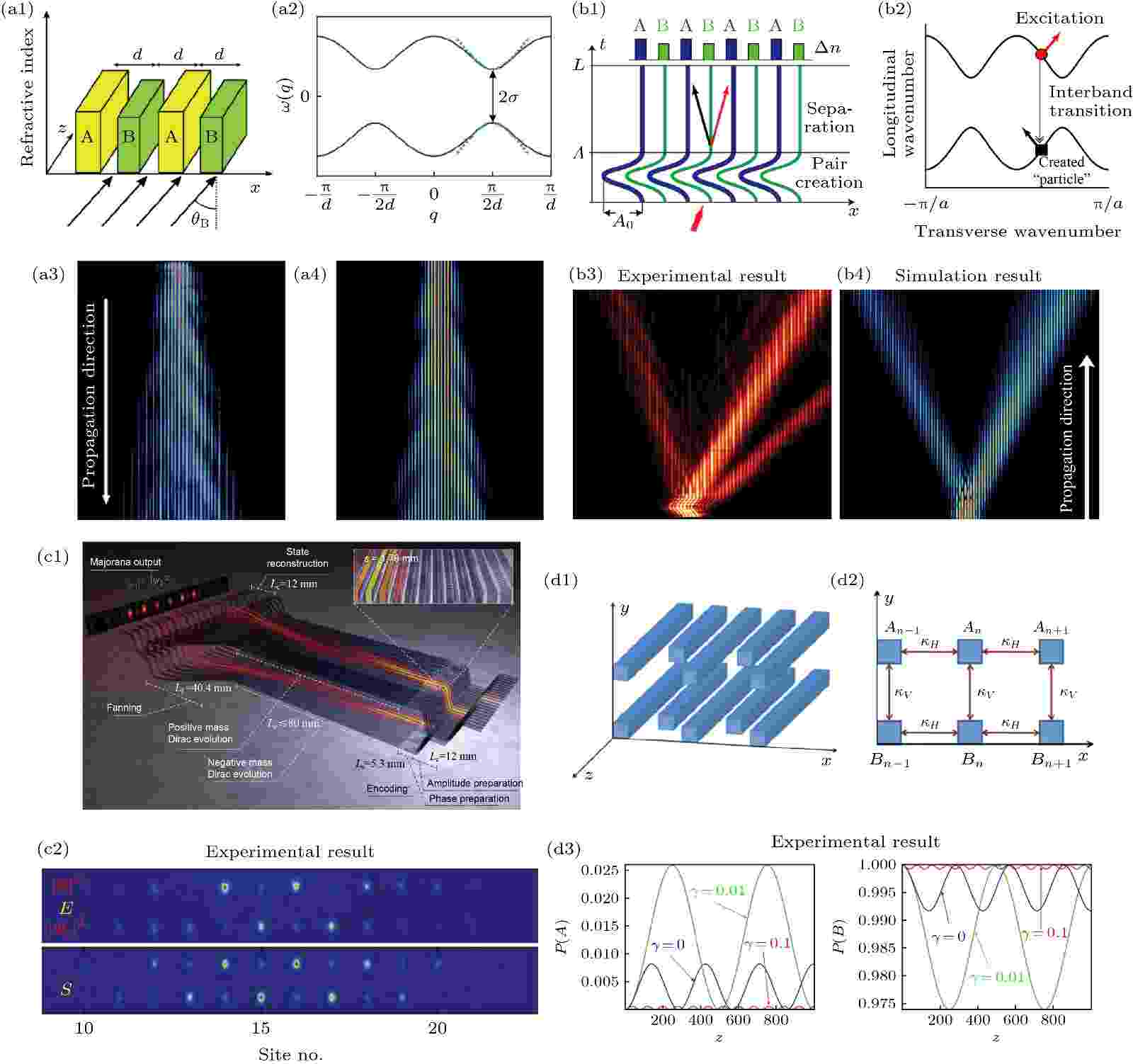 图 6 (a1)?(a4) 一维双组元波导阵列模拟广义相对论的Zitterbewegung效应, 其中(a1) 波导阵列的示意图, (a2) 波导阵列的色散, (a3) 实验结果图, (a4) 理论模拟图; (b1)?(b4) 一维弯曲的双组元波导阵列模拟正负粒子对的产生, 其中(b1) 波导阵列的示意图, (b2) 波导阵列的色散, (b3) 实验结果图, (b4) 理论模拟图; (c1), (c2) 波导阵列模拟Majorana费米子, 其中(c1) 波导阵列的示意图, (c2) 实验结果图; (d1)?(d3) 两层垂直放置的双组元的波导阵列模拟中微子振荡, 其中(d1) 波导阵列的示意图; (d2) 波导阵列耦合系数的设置; (d3) 实验结果图
图 6 (a1)?(a4) 一维双组元波导阵列模拟广义相对论的Zitterbewegung效应, 其中(a1) 波导阵列的示意图, (a2) 波导阵列的色散, (a3) 实验结果图, (a4) 理论模拟图; (b1)?(b4) 一维弯曲的双组元波导阵列模拟正负粒子对的产生, 其中(b1) 波导阵列的示意图, (b2) 波导阵列的色散, (b3) 实验结果图, (b4) 理论模拟图; (c1), (c2) 波导阵列模拟Majorana费米子, 其中(c1) 波导阵列的示意图, (c2) 实验结果图; (d1)?(d3) 两层垂直放置的双组元的波导阵列模拟中微子振荡, 其中(d1) 波导阵列的示意图; (d2) 波导阵列耦合系数的设置; (d3) 实验结果图Figure6. (a1)?(a4) Simulation of relativistic zitterbewegung using the one dimensional binary waveguide system: (a1) Schematic of the one dimensional binary waveguide system; (a2) the dispersion relation of the waveguide; (a3) the experimental results; (a4) the simulation results. (b1)?(b4) Simulation of pair production in vacuum using the curved waveguides: (b1) Schematic of the one dimensional curved waveguide; (b2) the dispersion relation of the waveguide; (b3) the experimental results; (b4) the simulation results. (c1), (c2) Simulation of Majorana fermions: (c1) Schematic of the waveguide system; (c2) the experimental results. (d1)?(d3) Simulation of neutrino oscillations: (d1) Schematic of two vertically displaced binary waveguides; (d2) transverse section of the structure; (d3) the experimental results.
除此之外, Lustig等[132]研究了弯曲表面上离散波导阵列的演化, 如图7(a)所示, 将一维波导阵列放置在弯曲的曲面上, 发现了由于空间弯曲而产生的拓扑边界态(图7(b)). Wang等[133]研究了黑洞视界附近正负粒子对的产生, 首先从1 + 1维施瓦西黑洞在视界附近处的度规出发, 考虑到无质量的弯曲时空的狄拉克方程, 理论计算获得了正负能量对的狄拉克粒子在黑洞视界附近的量子演化(图7(c)), 即正能粒子加速逃逸视界而负能粒子朝向视界运动, 最后在视界附近静止而被黑洞捕获. 为了在波导阵列光子芯片中模拟弯曲时空中的量子效应, 首先将连续弯曲时空的狄拉克方程离散化, 获得对应波导阵列耦合系数的关系. 实验中将单光子注入该理论设计的双层波导阵列中, 如图7(e)所示, 成功地观测到具有正能量的单光子波包逃逸而负能量的单光子波包被视界捕获的过程(图7(f)). 这个过程很好地对应了霍金辐射的部分过程. 除了单光子, 这个体系还可以拓展全同的双光子以及纠缠光子对在弯曲时空中的演化, 可以研究弯曲时空对量子干涉以及量子纠缠的影响.
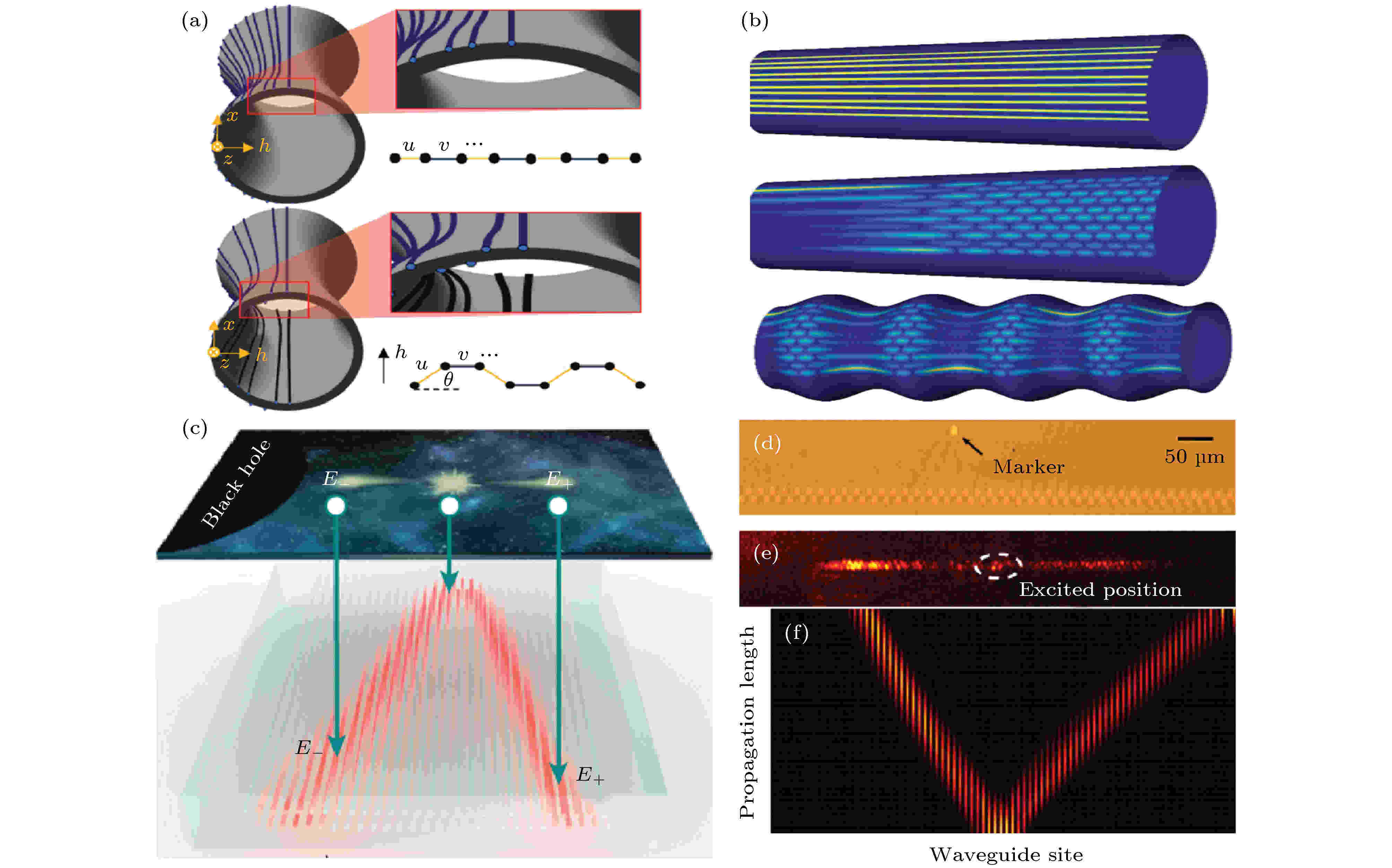 图 7 (a) 弯曲曲面上的波导阵列; (b) 弯曲的曲率对波导阵列中电磁波演化的影响; (c) 黑洞视界附近正负能量粒子对的产生的示意图; (d) 飞秒直写波导阵列的样品图; (e) 实验结果图; (f) 正负能量粒子对的演化
图 7 (a) 弯曲曲面上的波导阵列; (b) 弯曲的曲率对波导阵列中电磁波演化的影响; (c) 黑洞视界附近正负能量粒子对的产生的示意图; (d) 飞秒直写波导阵列的样品图; (e) 实验结果图; (f) 正负能量粒子对的演化Figure7. (a) Waveguide sites on the curved space; (b) the waveguide evolutions related with curvature of space; (c) the schematic of pair production near the event horizon of black hole; (d) a sample fabricated by femtosecond direct writing method; (e) the experimental result; (f) the evolution of the pair production.
